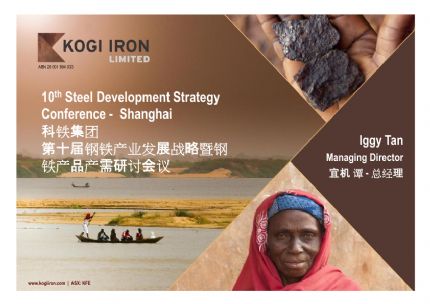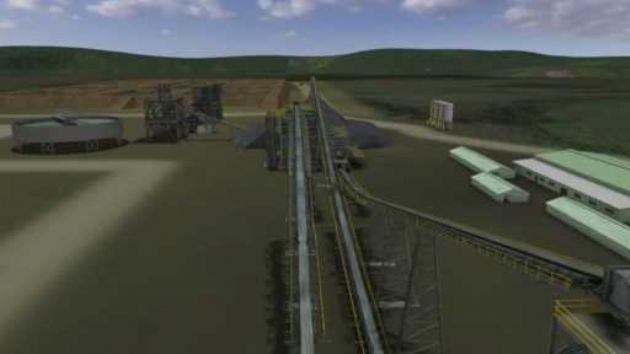 Finalises Agbaja Processing Plant Design
Finalises Agbaja Processing Plant Design
Perth, Jan 24, 2014 AEST (ABN Newswire) - Australian based iron ore development company, Kogi Iron Limited ( ASX:KFE) ("Kogi", "Kogi Iron", or the "Company") and it's 100% owned Nigerian operating company, KCM Mining Limited ("KCM") are pleased to report the finalisation of the processing plant design for its Agbaja Iron Ore Project in Kogi State, Nigeria ("Agbaja" or "Agbaja Project").
ASX:KFE) ("Kogi", "Kogi Iron", or the "Company") and it's 100% owned Nigerian operating company, KCM Mining Limited ("KCM") are pleased to report the finalisation of the processing plant design for its Agbaja Iron Ore Project in Kogi State, Nigeria ("Agbaja" or "Agbaja Project").
The processing plant design, which will be included in the Preliminary Feasibility Study ("PFS") that is nearing completion, has now been finalised and is based on a variety of test work programs carried out by Tenova Mining and Minerals (part of the global Tenova Iron & Steel and Mining Industries group) ("Tenova") and considers results from earlier metallurgical test work programs conducted by both Tenova and Trical Mining and Metallurgical Services ("Trical").
Tenova's PFS test work focussed on subjecting the mineralised Agbaja material to proven simple physical separation techniques to produce an iron ore concentrate with optimum finished product specifications. Test work found that the iron contained in the mineralised material begins to liberate at a size below about 1 mm, so a primary grind size of 600 micron has been selected for the processing plant, with a final grind size at a relatively coarse 250 micron.
Grinding will be followed by Low Intensity Magnetic Separation (LIMS) which is a robust, high capacity and well established mineral processing technology. For the Agbaja material, laboratory testing of LIMS has demonstrated sound primary separation of iron bearing material for a reasonable final product grade and yield, after regrinding of the material.
Yield is expected to be ~45%, for a final iron ore concentrate grade of ~56% Fe.
Processing flow sheet description
A three stage crushing circuit has been designed comprising of two double deck banana scaling screens, one primary crusher/sizer, one secondary cone crusher, two tertiary crushers and three single deck final product screens delivering a <15mm product (P80) to a conical mill feed stockpile (See Figure 1). The nominal throughput of the plant is 1,894t/hr to achieve 11.1Mtpa of feed. It is envisaged that crusher feed will be received in a primary crusher directly from the mine via dump trucks for the first stage of size reduction. From the primary crusher, material will report to an apron feeder sizer with >15mm material proceeding to secondary crushing and <15mm material feeding a ball mill via a 38,000t live stockpile.
The >15mm crushed material will be screened by a 3.0m wide by 7.3m long double deck banana screen with the oversize and middlings (>15mm) from both decks conveyed to a secondary cone crusher. The secondary crushed product will be screened by three 3.0m by 7.3m single deck banana screens and oversize material sent to third stage crushing consisting of two HP800 cone crushers. Discharge from the tertiary crusher will be combined with the secondary crusher feed.
The milling circuit will consist of one 6.7m diameter by 9.2m long ball mill with dual 4,500kW drives, operating in closed circuit with 30 multi-deck screens for classification of the solids. New feed to the grinding circuit will be reclaimed from the material stockpile by vibratory stockpile dischargers and conveyed to the mill hopper where it will be blended with screened mill oversize and Rougher Magnetic Separators (RMS) concentrate oversize. The mill will be sized to process a nominal, 3,900t/hr of solids based on a circulating load of 100% of new feed of 1,590t/hr. Mill discharge slurry density will be maintained at 70% solids by the controlled addition of water to the mill feed chute, and water addition to the mill discharge hopper will be controlled to ensure 50% solids density in the feed to one of the six sets of five multi deck screens. The objective of the multi-deck screen is to produce feed to the downstream Rougher Magnetic Separators (RMS) circuit from the undersize at a P80 of 250 µm. The oversize material (>250 µm) from the multi-deck screens will be returned to the ball mill. The underflow from the multi-deck screens will be collected, maintained at 35% density and fed to the RMS circuit.
Each RMS unit will be a single drum, low intensity magnetic separator (LIMS), counter current and operating under approximately 2000 Gauss magnetic strength at a distance of 50mm from the drum surface. The resulting concentrate (magnetic stream) is expected to recover 67% of the feed to the circuit and produce concentrate slurry at 60% solids density. The RMS product will be fed to a cleaner magnetic separation circuit (CMS) consisting of three four-way gravity distributors feeding a total of 12 triple drum magnetic separators. Each CMS unit will be a triple drum, LIMS, counter current and operating at approximately 2000 Gauss magnetic strength at a distance of 50mm from the drum surface.
The RMS concentrate will be upgraded by the CMS to a final Fe grade of 56%, with the non-magnetics reporting to tailings. The CMS is expected produce 5.0 Mtpa of concentrate to undergo microbial treatment to reduce the phosphorous content to 0.25% in open swimming pool style vats. Once the phosphorus levels have reached the targeted level, the slurry will be pumped out of the vats and thickened for pumping and transport to the Banda barge loading facility.
The slurry concentrate received at the Banda barge loading facility will be vacuum filtered and washed with water before being conveyed to the concentrate product load-out station at a maximum moisture content of less than 10% before being loaded onto river barges for transport. Recovered water will be returned back to the processing plant by pipeline with additional process water sourced from the Niger River.
It is envisaged that power for the plant will be provided by a dedicated natural gas power station, and power for the Banda barge loading facility and process water return pipeline will be provided by a diesel power plant.
Estimated PFS Processing Costs
As part of the PFS, the Company has estimated processing costs based on equipment power loads, employee salaries, consumables, maintenance, sample analysis, reagents, grinding media, and various other operating expenditures. The total estimate indicates that iron ore concentrate will cost in the region of US$16/t to process at Agbaja.
Kogi's Managing Director, Iggy Tan said "the proposed Agbaja processing plant uses a very simple beneficiation process for magnetite ore which will keep operating costs low. Magnetite deposits are typically found in banded ironstone formations (BIFs) whereas Agbaja is one of only three known channel iron deposits (CID) to host potentially commercial magnetite. Typical, BIF magnetite deposits require large amounts of energy intensive grinding (around 14 kWhr/t feed) to liberate the iron however the relative softness of the Agbaja CID material requires only moderate grinding (8.5 kWhr/t feed) and simple magnetic separation to liberate the iron. Consequently, mining and processing costs for Agbaja are expected to be very competitive when compared with other magnetite projects".
To view figures and diagrams, please visit:
http://media.abnnewswire.net/media/en/docs/ASX-KFE-664929.pdf
About Macro Metals Limited
Macro Metals Limited is an ASX-listed company (ASX:M4M) with the intent to build a cast steel plant on the Agbaja Plateau in Kogi State, Nigeria. The project will utilise company leased iron ore deposits and will supply a cast steel feedstock to steel manufacturing and product fabricators in Nigeria and overseas.
![abnnewswire.com]()
Related Companies
Social Media
Share this Article

 ASX:KFE) ("Kogi", "Kogi Iron", or the "Company") and it's 100% owned Nigerian operating company, KCM Mining Limited ("KCM") are pleased to report the finalisation of the processing plant design for its Agbaja Iron Ore Project in Kogi State, Nigeria ("Agbaja" or "Agbaja Project").
ASX:KFE) ("Kogi", "Kogi Iron", or the "Company") and it's 100% owned Nigerian operating company, KCM Mining Limited ("KCM") are pleased to report the finalisation of the processing plant design for its Agbaja Iron Ore Project in Kogi State, Nigeria ("Agbaja" or "Agbaja Project").




